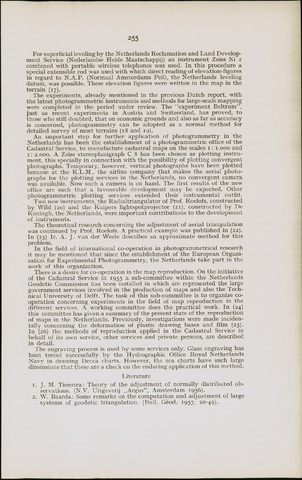255
For superficial leveling by the Netherlands Reclamation and Land Develop
ment Service (Nederlandse Heide Maatschappij) an instrument Zeiss Ni 2
combined with portable wireless telephones was used. In this procedure a
special extensible rod was used with which direct reading of elevation-figures
in regard to N.A.P. (Normaal Amsterdams Peil), the Netherlands leveling
datum, was possible. These elevation figures were written in the map in the
terrain (17).
The experiments, already mentioned in the previous Dutch report, with
the latest photogrammetric instruments and methods for large-scale mapping
were completed in the period under review. The "experiment Beltrum",
just as recent experiments in Austria and Switzerland, has proved, to
those who still doubted, that on economic grounds and also as far as accuracy
is concerned, photogrammetry can be adopted as a normal method for
detailed survey of most terrains (18 and rg).
An important step for further application of photogrammetry in the
Netherlands has been the establishment of a photogrammetric office of the
Cadastral Service, to manufacture cadastral maps on the scales 11.000 and
12.000. A Zeiss stereoplanigraph C 8 has been chosen as plotting instru
ment, this specially in connection with the possibility of plotting convergent
photographs. Temporary, however, vertical photographs have been plotted
because at the K.L.M., the airline company that makes the aerial photo
graphs for the plotting services in the Netherlands, no convergent camera
was available. Now such a camera is on hand. The first results of the new
office are such that a favourable development may be expected. Other
photogrammetric plotting services extended their instrumental outfit.
Two new instruments, the Radialtriangulator of Prof. Roelofs, constructed
by Wild (20) and the Kuipers lightspotprojector (2r), constructed by De
Koningh, the Netherlands, were important contributions to the development
of instruments.
The theoretical research concerning the adjustment of aerial triangulation
was continued by Prof. Roelofs. A practical example was published in (22).
In (23) Ir. A. J. van der Weele describes an approximate method for this
problem.
In the field of international co-operation in photogrammetrical research
it may be mentioned that since the establishment of the European Organi
zation for Experimental Photogrammetry, the Netherlands take part in the
work of this organization.
There is a desire for co-operation in the map reproduction. On the initiative
of the Cadastral Service in 1955 a sub-committee within the Netherlands
Geodetic Commission has been installed in which are represented the large
government services involved in the production of maps and also the Tech
nical University of Delft. The task of this sub-committee is to organize co
operation concerning experiments in the field of map reproduction in the
different services. A working committee does the practical work. In (24)
this committee has given a summary of the present state of the reproduction
of maps in the Netherlands. Previously, investigations were made inciden
tally concerning the deformation of plastic drawing bases and film (25).
In (26) the methods of reproduction applied in the Cadastral Service in
behalf of its own service, other services and private persons, are described
in detail.
The engraving process is used by some services only. Glass engraving has
been tested successfully by the Hydrographic Office Royal Netherlands
Navy in drawing Decca charts. However, the sea charts have such large
dimensions that these are a check on the enduring application of this method.
Literature
1. J. M. Tienstra: Theory of the adjustment of normally distributed ob
servations. (N.V. Uitgeverij „Argus", Amsterdam 1956).
2. W. Baarda: Some remarks on the computation and adjustment of large
systems of geodetic triangulation. (Bull. Géod. 1957, 20-49).

